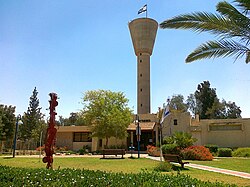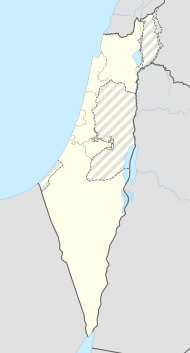Omer (Israel)
| Omer | ||
|---|---|---|

|
||
| Basic data | ||
| hebrew : | עומר | |
| State : |
|
|
| District : | south | |
| Founded : | 1961 | |
| Coordinates : | 31 ° 16 ' N , 34 ° 51' E | |
| Height : | 331 m | |
| Area : | 20.126 km² | |
| Residents : | 7586 (as of: 2018) | |
| Population density : | 377 inhabitants per km² | |
| Community code : | 0666 | |
| Time zone : | UTC + 2 | |
|
|
||
Omer ( Hebrew עומר) is an urban village in the south of Israel . It is located in the northern part of the Negev desert, 4 km from Beersheba . In 2018 the population was 7586.
The name is a symbolic reference to the omer ( biblical name for the sheaves from the first harvest in spring).
As early as 1949 there was a failed attempt to establish a settlement point in Omer. Today's Omer goes back to a new establishment in 1961.
In the 1970s, Omer became one of the most attractive places in the Negev. Professors, doctors, freelancers, and industrialists all settled down and made it one of the richest cities in Israel. Omer is the preferred place of residence for many professors and researchers at Ben Gurion University in the Negev .
Omer consists mainly of single-family houses in a well-kept townscape and thus represents a contrast to the surrounding area with many rather poor localities.
The city borders in the west on Beersheba, the regional central city (Omer can be called its satellite). In the south lies the Bedouin town of Tel Sheba , which is one of the poorest in Israel. North of the residential areas is a large industrial park, which was founded by the visionary industrialist Stef Wertheimer and which also houses an open museum. Knowledge-intensive companies are housed in the industrial park, and it is one of the most successful in Israel.
Omer is considered a role model for the later founded, also successful Negev towns of Lehawim and Meitar .
Web links
Individual evidence
- ↑ אוכלוסייה ביישובים 2018 (population of the settlements 2018). (XLSX; 0.13 MB) Israel Central Bureau of Statistics , August 25, 2019, accessed May 11, 2020 .
- ↑ אוכלוסייה ביישובים 2018 (population of the settlements 2018). (XLSX; 0.13 MB) Israel Central Bureau of Statistics , August 25, 2019, accessed May 11, 2020 .
